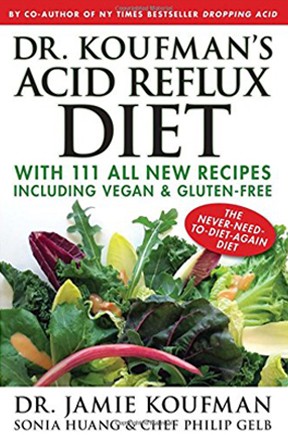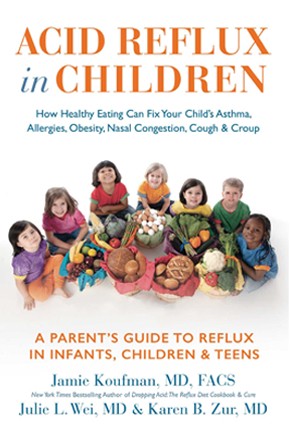
Who Is Dr. Jamie Koufman Respiratory Reflux Expert? Part II of II
At-A-Glance
- Dr. Jamie Koufman is an American physician and scientist whose research in laryngology and acid reflux has led to discoveries that have impacted two generations of physicians and patients.
- This post is personal and excerpted from my forthcoming book, Respiratory Reflux: How Silent Reflux Causes Diseases. It’s revealing that my alternative book titles were, “The History of Respiratory Reflux” and “Silent Reflux: A Memoire.
- This is part II of a two-part article; if you want to understand how I connected the dots. I strongly recommend that you read Part I
Join Facebook Live with Dr. Jamie Koufman the 1st Wednesday of the Month at Noon Eastern Time; and if You Have Questions About Respiratory Reflux Ask Them There. And If You Miss It Live, It Gets Posted to YouTube Afterwards.
This is part II of a two-part article; if you want to understand how I connected the dots, I Strongly Recommend That You Read Part I First.
Reflux Treatise
Around 1985, I wanted to join the prestigious Trilogical Society; however that required submitting a thesis, like a doctoral thesis. It took me five years to complete, and during the last year, the year of writing, I ate, breathed, and slept this piece of work. I hardly did anything else.
The clinical data were mined from 1985-88 patients in one of six categories: (1) cancer of the larynx, (2) subglottic stenosis (airway scarring below the vocal cords), (3) reflux laryngitis, (4) globus (lump-in-the-throat sensation), (5) dysphasia (difficulty swallowing), and (6) chronic cough. To be included, all had to have complete clinical evaluations, including double-probe pH-metry.
The results were staggering; all of the groups had abnormal pH-metry. Most notable were the results of subglottic stenosis and cancer of the larynx; abnormal pH-metry was seen in 92% and 84% respectively. Those data suggest that LPR might be causal.
I also conducted animal laboratory experiments to examine the role of acid and pepsin in causing laryngeal injury. Interestingly, the animals treated with saline or acid alone all healed; however, those treated with acid and pepsin did not. Furthermore, there was comparable inflammation and tissue damage with acid at pH 1.5, pH 2.5, and pH 4.0. (In later experiments in my cell biology laboratory, we would show that the larynx can be injured by acid at pH 5 or less in the presence of pepsin … by the way all soft drinks have a low pH.)
The final manuscript was a two-volume, 377-page behemoth. In it, I reviewed the world’s literature on acid reflux, more than 8,000 articles; in the thesis, I included the 613 most important articles. This was the first time anyone had presented data of this type and magnitude. This massive clinical investigation made the results very difficult to ignore.
This was my Magnum opus; after its 1991 publication, I was vaulted into celebrity in the academic world. I was invited to lecture everywhere and at prestigious institutions such as Harvard, Hopkins, Yale, Vanderbilt, UCLA, Mayo, and Cleveland Clinics, just to name a few. I also lectured abroad, e.g., in the Netherlands, Turkey, Italy, England, Scotland, Sweden, Brazil, and Canada … I was the visiting professor and keynote speaker at the Royal College of Medicine in London and the Karolinska Institute in Stockholm. In addition, I was also asked to give keynote addresses at various medical societies and organizations, but never at GI one.
Cell Biology
It was clear that understanding the biology of pepsin was key to understanding reflux. So in 2001, I hired Dr. Nikki Johnston part-time from Dundee, Scotland. Two years later, I hired her full-time to study cell biology, and she moved to the U.S.
Our research elucidated the activity of pepsin at different pH levels and revealed that both laryngeal and esophageal tissue damage was due to pepsin, with esophageal damage occurring at pH<4 and laryngeal damage at pH<5. We proved that pepsin could be found in laryngeal biopsies of patients with respiratory reflux and laryngeal cancer. Another major piece of the puzzle was the realization that pepsin breaks down at pH>8; and that it survived acid-suppressive anti-reflux treatment. At present, we are working on Antipepsin Treatments.
Our cell biology work was breathtakingly novel and important, but nobody noticed. That’s because we published our work in the otolaryngology literature, and alas, few otolaryngologists read basic science papers, and in those days, people from other fields did not read the otolaryngology literature.
This was particularly true of the GIs, who were even less inclined than others to read our research because of the threat it posed to their well-established business model. Because they weren’t actually reviewing our published data, they effectively formed their opinions based on their defensive instinct, which became more acute with each paper we published. Thus, I found myself in an ironic situation where the more we published, the less my colleagues understood.
Transnasal Esophagoscopy: A Technologic and Clinical Breakthrough
In 1999, the Pentax Corporation brought me one of their first ultra-thin, flexible, transnasal esophagoscopes to examine the esophagus and stomach. Unlike the endoscopes used by GIs and others, which are large and inserted into the mouth, this thin scope was easily and painlessly passed through the nose, hence the name transnasal.
Transnasal esophagoscopy (TNE) was going to be a game changer. Unlike GI exams using endoscopes for esophagogastroduodenoscopy (EGD), which are done with sedation in a special facility… with a death rate of 1:9,000 exams, TNE was performed in the office with the patient awake and comfortable. No sedation is necessary, and the procedure was/is completely safe. And the time savings? With no recovery time, patients can be in and out of the office in less than an hour.
Simply put, TNE is the diagnostic that should be used for screening examinations of the esophagus and stomach. In fact, TNE should – and, I believe, ultimately will – completely replace EGD. Of course, GIs have been utterly resistant to this newer, better method. Sadly, their existing practice is just too lucrative to give up – it’s as simple as that.
When I first began performing TNE, Medicare physician reimbursement for the procedure was about three times the rate for EGD. Perhaps this was Medicare’s way of encouraging TNE as a less-expensive alternative to EGD—and if so, it could have been seen as a tacit endorsement of TNE’s superiority as a diagnostic tool.
However, in 2014, Medicare reimbursement for TNE (CPT 43197) was adjusted downward to a mere $187, but if it was done in a “facility,” the reimbursement (professional and facility fees) was $945. The GIs had successfully killed TNE; it was intended to be an office-based procedure, and adding a facility fee while lowering the professional fee should never have happened.
For us working in offices, most ENTs, the reimbursement at the new level did not cover costs. Today, many who used to perform TNE have given it up. This adjustment was effectuated as a direct result of lobbying by GIs. I would like to get inside Medicare and tell them the truth … that TME absolutely should replace sedated GI endoscopy.
The Big Apple
I always wanted to live in New York City. In 2006, I left North Carolina and Wake Forest to pursue private practice in Manhattan. New York was good to me. In addition to having a gorgeous office across from Carnegie Hall with a nice view of Central Park, I ran an exciting global medical practice that included celebrities. I enjoyed a larger-than-life experience in the Big Apple, appearing on television, walking red carpets, and hanging out with stars. Life was great.
Though I no longer worked in a university setting, my academic connections were not lost. In 2008, I was president of the American Broncho-Esophagological Association (ABEA); in 2011, I won the James Newcomb Award, a lifetime achievement award of the American Laryngological Association; in 2014, I was President of the New York Laryngological Society; and in 2017, I won the ABEA’s Chevalier Jackson Award.
Incidentally, Dr. Nikki Johnston continued work on pepsin at the Medical College of Wisconsin. Since 2006, her work has shown that pepsin can cause cell damage without acid and that pepsin is carcinogenic—it up-regulates cancer markers in laryngeal cell cultures. We are now working on Antipepsin Treatments.
Dropping Acid
When my first reflux book, Dropping Acid: The Reflux Diet Cookbook & Cure, was published in 2010, that was the first time anyone had ever linked the three words reflux, diet, and cure. How did I make the connection? It all had to do with pepsin. After discovering that damaging pepsin could bind to tissue in the esophagus and airways and be reactivated by acid in the diet, it became clear that controlling dietary acid was key to managing–and, yes, curing–reflux.
In 1979, the FDA started mandating the acidification of non-pasteurized bottled and canned foods and drinks to prevent the growth of microorganisms. While this undoubtedly had a public health benefit in terms of reducing food poisoning, I believe this single decision is responsible for starting the current epidemic of reflux we’re experiencing in this country. Today, many foods and beverages are as acidic as stomach acid.
While reflux was historically thought of as a condition of middle-aged and older people with unhealthy diets and lifestyles, patients coming through my office were often younger and fitter–not the old profile of the stereotypical refluxer. The common denominator was acid in the diet, which doesn’t care who you are or what you look like.
Following Dropping Acid, in 2011, I published a paper entitled, Low-acid diet for recalcitrant laryngopharyngeal reflux: Therapeutic benefits and their implications, in which I presented data on the beneficial effect of a low-acid diet on controlling reflux symptoms. Soon after, the New York Times ran an article–Tired of Feeling the Burn? Low-Acid Diet May Help, by Tara Parker-Pope–covering my paper and book.
Flood Gates Open
After that, the floodgates opened. I began to see every possible kind of reflux patient with every kind of symptom. Equipped with the world’s best custom-made reflux-testing technology, pH-metry, I could definitively identify reflux in connection with conditions in ways that I hadn’t seen or reported before. As data, experience, and new discoveries piled up, I felt light bulbs flashing left and right.
By this time, I already had decades of data connecting reflux with a host of symptoms and diagnoses, including asthma, pseudo-asthma, shortness of breath, choking episodes, sore throat, post-nasal drip, chronic throat-clearing, laryngitis, globus (lump-in-the-throat sensation), dysphagia (difficulty swallowing), chronic bronchitis, non-pulmonary cough, and laryngeal cancer. But, as I found out, I still had more to learn.
One year, I saw a volley of patients with nasal, sinus, and facial pressure symptoms who had all had sinus surgeries–and were all as mad as hornets because the surgery had done nothing for their symptoms. One patient, who had actually had three sinus surgeries, expressed the common sentiment, Look, I know all this was LPR. It was LPR then, and it’s LPR now… Please, just fix me!
The Chronic Cough Enigma
Another big problem was chronic cough/ Over the course of my career, I accumulated a lot of information and knowledge about reflux-caused chronic cough, and Neurogenic Cough, which is a cough caused by a faulty Vagus Nerve. I wrote a paper for publication on the causes of non-pulmonary chronic cough and provided significant data.
The paper was scientifically solid and provided good, new information; however, it was rejected outright. Reviewers made ridiculous comments; one said the chronic cough that I was talking about was a psychogenic or psychological problem, and the other said I must simply be missing lung disease.
Let me clarify, here I am talking about non-pulmonary chronic cough. My patients have no lung disease, and they must be checked out before they are booked to see me. That said, I do see people with known lung disease who might have respiratory reflux as a cause or accelerating factor.
So, my paper was rejected, so I wrote The Chronic Cough Enigma. Indeed, the most common cause of chronic cough is Silent Nocturnal Respiratory Reflux. The second most common cause is neurogenic cough, and the third most common cause of chronic cough is a group of blood pressure medicines commonly used today, ACE-inhibitors.
Did You Hear The Last Shoe Fall?
The relationship between RR and Laryngitis, Sinusitis, Asthma, Bronchitis, COPD, and almost every respiratory disease is firm. Still, one unanswered question remained: Did RR cause ear symptoms?
That last shoe dropped in 2015 when a twenty-nine-year-old computer programmer from Washington, D.C., came to me very agitated. He told me that he had disabling ear symptoms, including hearing loss, ear pressure, ear pain, and tinnitus, all of which he was certain were caused by reflux.
He threw up his hands when he told me that he had already seen many physicians and had many tests; the most common diagnosis was that it was all in his head and that he needed to see a psychiatrist. On examination, I found severe inflammation around his eustachian tubes and his reflux testing was off the charts. I treated him with a very stringent anti-reflux detox protocol, and he returned to see me six weeks later with a big smile on his face.
Since that pioneer patient, I’ve encountered many other patients complaining of similar ear symptoms. Those patients also showed inflammation of the eustachian tubes and responded to antireflux treatment.
My experiences with perhaps 100,000 patients over my career bring me to an inflection point in my story. While I was no longer as active in the research community, my work was now being corroborated by an entirely new audience–the general public. Not only did it feel great to be able to help so many people, but, following the publication of my books and blog, patients began accurately self-diagnosing and effectively self-treating.
Guillotine Retirement
In January 2020, I got Covid before we knew the word “Covid.” I was extremely sick with pneumonia but never hospitalized. During the course of my recovery, I decided that it was time to retire. But in truth, I never wanted to leave New York or to retire; but my health was bad.
I am now living in North Carolina with severe complications of long-Covid, including Cardiac Complications. Meanwhile, I am still busy. I do virtual medical consulting two days a week, and yes, you can Do A Consultation With Me. In addition, I write a weekly blog and am working on a new book.
Medically, Y’all Are Getting a Pig in a Poke, Sorry …
I have no plans to go back into medical practice because of my age, health limitations, and problems within healthcare. It’s hard for me to say this, but the state-of-the-art regarding Respiratory Reflux is much worse today than it was a generation ago; some of it is related to Medicare and GI. To my knowledge, nobody’s picked up the slack of my work, with the exception of Dr. Nikki Johnston, who is a basic scientist.
People often ask if I can recommend a doctor who knows what I know, but I cannot. The fragmentation of the Aerodigestive Tract into atomic boxes with the “go-to” doctor for acid reflux is the clueless and conflicted gastroenterologist, leaves approximately 100 million Americans, with Silent Nocturnal Respiratory Reflux with nowhere to go for accurate diagnosis and treatment.
By the way, it is essential that you understand that acid reflux in all its forms is not a medical problem. There are no pills or procedures that will make reflux go away … even if you have the best surgery by the best surgeon. If you’re eating big meals late and with alcohol, for example, it doesn’t matter what kind of antireflux treatment … even if you had surgery, your reflux will endure.
Respiratory Reflux and Integrated Aerodigestive Medicine: The New Frontier
Think about the implications of this. My book, Dropping Acid, has been the #1 best-seller in Asthma on Amazon for years. That tells me that people are figuring out the relationship between RR and their breathing problems even though their doctors cannot.
I’ve written this blog to share my knowledge and experience and put it in the public domain. This was/is a refreshing change from seeing my work filter through a slow-moving, self-interested medical ecosystem. Here, I am addressing my would-be patients directly.
The history of medicine is a story of novel discoveries leading to paradigm shifts in how we understand and care for the human body. Nobody else has done what I’ve done or embraced this practice in the way I have – yet. But I am convinced that, in time, the model of respiratory reflux I describe will become the new paradigm. If I didn’t genuinely believe that, I wouldn’t have spent my career studying it, and I wouldn’t have been able to bring relief to so many people.
The new frontier will be Integrated Aerodigestive Medicine. This is a talk, 45-minute lecture, that I gave at the Boston University Medical Center the July before Covid.) How does this tie into improving healthcare while reducing costs? Here’s the three-part answer.
First, the gastroenterology “heartburn business model” must be rejected by Medicare, and TNE (Transnasal Esophagoscopy) must be reinstated as the preferred esophageal screening test for people with acid reflux. Medicare must also remove any facility fee for TNE and make it an office-based procedure.
Second, primary care physicians (PCPs), other physicians, physician assistants, nurse practitioners, and/or speech-language pathologists must be trained in Integrated Aerodigestive Medicine (IAM) and trained to perform throat and TNE examinations. Once the respiratory and digestive tracts are treated as one unit, innervated by the vagus nerve, healthcare professionals can be trained to do throat and esophageal examinations; and ideally, the IAM curriculum would train PCPs to diagnose and treat problems that specialists now mismanage at great cost. Such conditions include post-nasal drip, allergies, sinusitis, asthma and other breathing problems, respiratory and esophageal reflux, chronic cough, bronchitis, and COPD … specialists would be consulted as needed.
Three, primary care must be revived and elevated (paid well) with governmental support, if needed, to encourage young people to go into primary care. The PCP must be the gatekeeper for patients with all common ailments. This is how it is done in every country with universal healthcare—believed by most people to be a basic human right—to control costs. Cost control is needed before the U.S. can expand healthcare coverage to all.
If PCPs were trained in RR and IAM, we could save a trillion dollars a year in healthcare costs and patients would also get better care.
Please subscribe to this blog to stay current; if you would like to schedule a virtual consultation with me, you can Book It Online.









